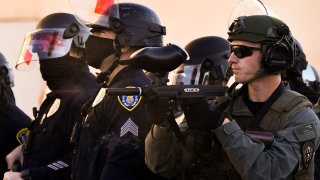
As required by a new state law, the San Diego Police Department on Thursday released a draft procedure for its funding, acquisition and use of military-style equipment, including drones, battering rams, concussion grenades, large-caliber firearms and armored or weaponized vehicles.
The proposals, available for community review on the SDPD's website, will be the subject of several municipal public meetings in the coming weeks ahead of the review, input and approval of the city council.
Sign up for our Breaking news newsletter to get the most urgent news stories in your inbox.
Along with publishing their intentions on acquiring and deploying such specialized equipment, SDPD officials must compile an annual report summarizing each type of involved apparatus, as well as its use, costs, quantity and any complaints or internal audits related to violations of the procedures.
Get San Diego local news, weather forecasts, sports and lifestyle stories to your inbox. Sign up for NBC San Diego newsletters.
In announcing the program, Mayor Todd Gloria said he was "proud San Diego is one of the first cities in California to develop [procedures] to comply with this new state law."
Gov. Gavin Newsom approved the bill Sept. 30, requiring California law enforcement agencies to obtain approval of their governing bodies — mayors and city councils — for the use of military-style gear. The law mandates that police agencies seek approval of such equipment at open community meetings prior to taking certain specified actions relating to its funding, acquisition and use.
Local
"The San Diego Police Department understands the desire for greater transparency when it comes to the equipment officers use to keep the community safe," Police Chief David Nisleit said. "Meeting the requirements laid out in Assembly Bill 481 has been a massive undertaking by SDPD personnel. We look forward to showing how these tools are used to de-escalate dangerous situations in our neighborhoods and how they are crucial to our public safety efforts."
AB 481 also governs civilian law enforcement agencies' participation in the federal 1033 Program, which enables local law enforcement agencies to acquire and maintain surplus military items through the U.S. Defense Logistics Agency, but the SDPD does not participate in that system, according to city officials.
"Assembly Bill 481 mandates transparency and oversight of the costs associated with and use of military-grade equipment," Gloria stated. "I championed legislation like this during my time in the Assembly, and I'm pleased to see it implemented here."
Photos: George Floyd Protests, Unrest Across San Diego
In addition to listing types of military-grade equipment that the San Diego Police Department potentially could use, the draft policy outlines training requirements officers must undergo to deploy the gear and methods of funding it, including "applying for a grant, soliciting or accepting private, local, state or federal funds, in-kind donations or other donations or transfers."
The recently enacted state law designates the following as military equipment:
- Unmanned, remotely piloted aerial or ground vehicles
- Mine-resistant, "ambush protected" vehicles or armored personnel carriers
- "High mobility" multipurpose wheeled vehicles, 2.5- and 5-ton trucks, or wheeled vehicles that have a breaching or entry apparatus attached
- Armored vehicles that provide ballistic protection to their occupants and use tracks instead of wheels for mobility
- "Command and control" vehicles that are built or modified to facilitate operational control and direction of public safety personnel and equipment
- Weaponized vehicles, including aircraft
- Battering rams and breaching apparatuses that are "explosive in nature"
- Firearms and ammunition of .50 caliber or greater, excluding standard-issue shotguns and shotgun ammunition
- Specialized firearms and ammunition of less than .50 caliber, including firearms and accessories identified by law as assault weapons, with the exception of standard-issue handguns
- Any gun or firearm accessory designed to launch explosive projectiles
- "Flash bang" grenades, explosive breaching tools, "pepper ball" projectiles and tear gas, excluding standard service-issued hand-held pepper spray
- Taser Shockwave electroshock "cannons," microwave weapons, water cannons and long-range acoustic devices
- Projectile-launching platforms and associated munitions, including 40mm projectile launchers, beanbags, rubber bullets and "specialty impact" munitions
- Any other equipment as determined by a governing body or state agency to require additional oversight
California law enforcement agencies must seek approval of such equipment prior to May 1 for any gear acquired before the beginning of this year.
Working with the Independent Commission on Police Practices, the SDPD will present the draft procedure and 2021 Military Equipment Annual Report at a public meeting of the panel on Feb. 22, then at a hearing of the Public Safety and Livable Neighborhoods Committee in early March, according to city officials.
Once approved by the city council, the final procedures will be posted to the SDPD's "policies and procedures" section of its website, as well as its "mandated disclosures" online page



